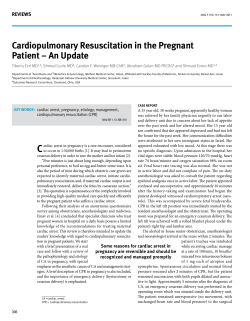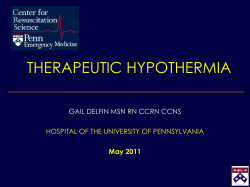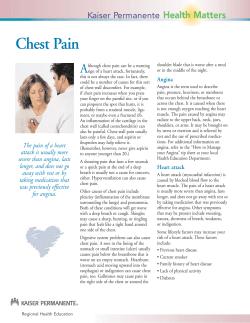
Sudden Obstetric Collapse STEPWISE RESUSCITATION
Sudden Obstetric Collapse STEPWISE RESUSCITATION Dr Alpesh Gandhi, Ahmedabad Chairman, Practical Obstetrics Committee, FOGSI. Sudden Obstetric Collapse • • • • • • Rare but potentially life threatening condition. Treatable if diagnosed and managed efficiently. Do not lose confidence, confidence and presence of mind will determine the outcome for the patient. Majority occur due to haemorrhage, but after ruling out same, immediately start resuscitation and search for cause. For better management and medico- legal aspect, keep a note of the drugs administered. Keep the labour room and OT ready to deal with any crisis. Sudden Obstetric Collapse • • • • • • • • • • • Massive obstetric haemorrhage Non-haemorrhagic shock Amniotic fluid embolism Acute uterine inversion Rupture of the uterus Eclampsia Ectopic pregnancy Pulmonary Embolisation Anaesthesia’s complications Mendlesons syndrome. Acute MI and others. What to do immediately in a case of sudden obstetric collapse? • • • STEPWISE RESUSCITATION ABC & ACLS (Advance Cardiac Life Support) MANAGEMENT SPEED MAKES THE DIFFERENCE ABC- Step wise Resuscitation Airway, Breathing and Circulation • • • • • ABC protocol remind the importance of airway, breathing, and circulation for maintenance of a life. These three issues are paramount in any treatment. The loss or loss of control of any one of these will rapidly lead to the patient's death. Airway, breathing, and circulation work in a cascade. If the pt's airway is blocked, breathing will not be possible, oxygen cannot reach the lungs & be transported around the body in the blood, which will result in hypoxia & cardiac arrest • Ensuring a clear airway is therefore the first step in treating any pt; once it is established that a pt's airway is clear, evaluate a pt's breathing, as many other things besides a blockage of the airway could lead to absence of breathing. • Cardiac arrest is mainly the ultimate cause of clinical death, and it is linked to an absence of circulation in the body, for any reason. • For this reason, maintaining circulation is vital to moving oxygen to the tissues and carbon dioxide out of the body. Simple application for CPR • In this simple usage, the rescuer is required to open the airway and then check for normal breathing • These two steps should provide the initial assessment of whether the patient will require CPR or not. • If the patient is not breathing normally, the current international guidelines indicate that chest compressions should be started. • Previously, guidelines indicated that a pulse check (Circulation) should be performed after the breathing was assessed. • But this pulse check is no longer recommended, since performing chest compressions is effective for artificial circulation. • When assessing patients who are breathing, assessing 'circulation' is still important. • However, some trainers now use the C to mean 'Compressions' in their basic first aid training. A — Airway (Unconscious patients) • Common problems with the airway of pt are blockage of the pharynx by tongue, foreign body, or vomit. • Opening of the airway is achieved through manual movement of the head using various techniques, widely used being the "head tilt — chin lift", other methods such as the "modified jaw thrust" can be used, especially where spinal injury is suspected. • Higher level practitioners may use more advanced techniques, from oro-pharyngeal airways to intubation, as deemed necessary. • Conscious patients • In the conscious patient, other signs of airway obstruction that may be considered by the rescuer include paradoxical chest movements, use of accessory muscles for breathing, tracheal deviation, noisy air entry or exit, and cyanosis. B-Breathing (Unconscious patients) • • • • Once the airway is opened the next area to assess is the pt's breathing. Normal breathing rates are between 12 - 20 / min. If a pt is breathing below the minimum rate, then in current ILCOR protocols, CPR should be considered, although rescuers may have their own protocols to follow, such as artificial respiration. Don’t mistaking agonal breathing, which is a series of noisy gasps occurring in around 40% of cardiac arrest victims, for normal. If a pt is breathing, then continue with the treatment indicated for an unconscious but breathing pt, like interventions such as the recovery position and summoning an ambulance. • Listening to external breath sounds a short distance from the pt can reveal dysfunction such as a rattling noise (indicative of secretions in the airway) or stridor indicates airway obstruction). • Checking for surgical emphysema which is air in the subcutaneous layer. • Auscultation and percussion of the chest to listen for normal chest sounds or any abnormalities. • Pulse oximetry- useful in assessing the amount of oxygen present in the blood, and by inference the effectiveness of the breathing. Conscious or breathing patients • • • • In a conscious pt, or where a pulse and breathing are clearly present, look to diagnose immediately lifethreatening conditions such as severe pulmonary oedema or haemothorax. Checking for general resp. distress, such as use of accessory muscles, abdominal breathing, position of the pt, sweating, cyanosis Checking the respiratory rate, depth and rhythm - If any of these deviate from normal, may indicate an underlying problem. Chest deformity and movement - Chest should rise and fall equally on both sides, should be free of deformity. Abnormal movement or shape may be there in pneumothorax, haemothorax. C- Circulation / Compressions (Non-breathing patients) • Once oxygen can be delivered to the lungs by a clear airway and efficient breathing, there needs to be a circulation to deliver it to the rest of the body. • Original meaning of the 'C’ is to assess the presence or absence of circulation, usually by taking a carotid pulse, before taking any steps. • In modern protocols it is omitted as it may have difficulty in accurately determining the presence or absence of a pulse, and there is less risk of harm by performing chest compressions on a beating heart than failing to perform them on a non beating heart • For this reason, lay rescuers proceed directly to CPR, starting with chest compressions, which is effectively artificial circulation. • However, health care professionals may often still include a pulse check in their ABC check, and may involve additional steps such as an immediate ECG . Breathing patients • • • • • • • • An opportunity to undertake further diagnosis, assessment options are: Observation of colour and temperature of hands where cold, blue, pink, pale, or mottled extremities can be indicative of poor circulation. Capillary refill is an assessment of effective working of capillaries, apply cutaneous pressure to an area of skin & count the time until return of bl. Pulse checks, both centrally and peripherally, assessing rate, regularity, strength, and equality between different pulses. B.P. measurements can be taken to assess for signs of shock. Auscultation of the heart can be undertaken. Observation for secondary signs of circulatory failure such as oedema or frothing from the mouth (indicative of congestive heart failure) ECG monitoring will help to diagnose underlying heart conditions like MI Variations DR ABC • One of the most widely used adaptations is the addition of "DR" in front of "ABC", which stands for Danger and Response. • This refers to the guiding principle in first aid to protect yourself before attempting to help others, and then ascertaining that the patient is unresponsive before attempting to treat them. • In some areas, the related SR ABC is used, with the S to mean Safety. ABCD • • • • • There are several protocols taught which add a D to the end of the simpler ABC (or DR ABC). This may stand for different things, depending on what the trainer is trying to teach, and at what level. It can stand for: Defibrillation— The definitive treatment step for cardiac arrest. Disability or Dysfunction— Disabilities caused by the injury, not pre-existing conditions. Differential Diagnosis Decompression ABCDEF • An 'F' in the protocol can stand for: • Fundus— relating to pregnancy, it is a reminder for crews to check if a female is pregnant, and if she is, how far progressed she is from the fundal hieght. • Family — indicates that rescuers must also deal with the witnesses and the family, who may be able to give precious information about the accident or health of the pt, or may present a problem for the rescuer. • Fluids — A check for obvious fluids (blood, CSF etc.) • Fluid resuscitation New emergency care guidelines • • • It includes dramatic changes to CPR and emphasis more on chest compressions. It emphasizes that high-quality CPR, particularly effective chest compressions, contributes significantly to the successful resuscitation of cardiac arrest pts. Studies show that effective chest compressions create more blood flow through the heart to the rest of the body, buying a few minutes until defibrillation can be attempted or the heart can pump blood on its own. The guidelines recommend that rescuers minimize interruptions to chest compressions and suggest that rescuers ―push hard and push fast‖ when giving chest compressions( ½ -2 cms). • The most significant change to CPR is to the ratio of chest compressions to rescue breaths – from 15 compressions for every two rescue breaths in the 2000 guidelines to 30 compressions for every two rescue breaths in the 2005 guidelines. • Studies show that blood circulation increases with each chest compression in a series & must be built back up after interruptions • Previously, when AED pads were applied to the chest, the device analyzed the heart rhythm, delivered a shock if necessary, and analyzed the heart rhythm again to determine whether the shock successfully stopped the abnormal rhythm. • The cycle of analysis, shock and re-analysis could be repeated 3 times before CPR was recommended, resulting in delays of 37 sec or more. • Now, after one shock, the new guidelines recommend that rescuers provide about two minutes of CPR, beginning with chest compressions, before activating the AED to re-analyze the heart rhythm and attempt another shock. • Studies have shown that the first AED shock stops the abnormal cardiac arrest rhythm > 85 percent of the time and that a brief period of chest compressions between shocks can deliver oxygen to the heart, increasing the likelihood of successful defibrillation. • It recommends to minimize interruptions to chest compressions by doing heart rhythm checks, inserting airway devices, and administering of drugs without delaying CPR. • To increase successful resuscitation, new guidelines advise to shorten the response time for cardiac arrest pts, then document the impact of such changes on the number of lives saved. • The guidelines are based on the Consensus on Science and Treatment Recommendations (CoSTR), a document developed by the International Liaison Committee on Resuscitation which includes the American Heart Association and leading international resuscitation councils. Here is a graphic illustration of the steps in CPR Always add "1000" after every number when counting from 1 to 30. Adding a "1000" word will make the pace of chest compressions regular and mimic the normal beat of the heart. •In a scene of an accident always look around and check if the scene is safe, you do not want to become one of the victims. •Do not bend your elbows when doing chest compressions, doing so will deliver a weak and ineffective chest compression. In obstetrics cases Key Points Interventions to Prevent Arrest • During resuscitation there are two patients, mother & fetus • The best hope of fetal survival is maternal survival. • Consider the physiologic changes due to pregnancy. To treat the critically ill pregnant patient: • Place the patient in the left lateral position. • Give 100% oxygen. • Establish IV access and give a fluid bolus. • Consider reversible causes of cardiac arrest and identify any preexisting medical conditions that may be complicating the resuscitation. Resuscitation of the Pregnant Woman in Cardiac Arrest Modifications of Basic Life Support • • • • • At GA > 20 weeks, the pregnant uterus can press against the IVC & aorta, impeding venous return and cardiac output. Uterine obstruction of venous return can produce pre-arrest hypotension or shock and in critically ill pt may precipitate arrest. It also limits the effectiveness of chest compressions. The gravid uterus may be shifted away from the IVC & aorta by placing in LUD or by pulling the gravid uterus to the side. This may be accomplished manually or by placement of a rolled blanket or other object under the right hip and lumbar area. Modifications of Basic Life Support : Airway • Hormonal changes promote insufficiency of the gastro- esophageal sphincter, increasing the risk of regurgitation. • Apply continuous cricoid pressure during positive pressure ventilation for any unconscious pregnant woman. • Secure the airway early in resuscitation. • Use an ETT 0.5 to 1 mm smaller in internal diameter than that used for a nonpregnant woman of similar size because the airway may be narrowed from edema. Modifications of Basic Life Support : Breathing • Hypoxemia can develop rapidly because of decreased FRC & increased O2 demand, so be prepared to support oxygenation & ventilation. • Ventilation volumes may need to be reduced because the mother’s diaphragm is elevated. Modifications of Basic Life Support : Circulation • Perform chest compressions higher, slightly above the center of the sternum as there is an elevation of the diaphragm & abdominal contents. • Vasopressor agents, including epinephrine & vasopressin, will decrease blood flow to the uterus, but since there are no alternatives, indicated drugs should be used in recommended doses Modifications of Basic Life Support : Defibrillation • Defibrillate using standard ACLS defibrillation doses. • There is no evidence that shocks from a direct current defibrillator have adverse effects on the heart of the fetus. • If fetal or uterine monitors are in place, remove them before delivering shocks. Modifications of Basic Life Support : D/D • Same reversible causes of cardiac arrest that occur in non-pregnant women can occur during pregnancy. • Providers should be familiar with pregnancy specific diseases & procedural complications. • Use of abdominal US should be considered in detecting possible causes, but this should not delay other treatments. Modifications of Basic Life Support : D/D • • • • Excess magnesium sulfate Iatrogenic overdose is possible in women with eclampsia, particularly if the woman becomes oliguric. Administration of cal. gluconate is treatment of choice. Empiric calcium administration may be lifesaving. Pre-eclampsia/eclampsia Pre-eclampsia/eclampsia can produce severe HTN & ultimate diffuse organ system failure If untreated it may result in maternal and fetal morbidity & mortality Modifications of Basic Life Support : D/D Acute coronary syndromes • Pregnant women may experience ACS, typically in association with other medical conditions • Because fibrinolytics are relatively contraindicated in pregnancy, PCI is the reperfusion strategy of choice for STEMI Life-threatening PE & stroke Successful use of fibrinolytics for a massive, life-threatening PE & ischemic stroke have been reported in pregnant women. Aortic dissection Pregnant women are at increased risk for spontaneous aortic dissection Trauma • Pregnant women are not exempt from the accidents & mental illnesses • Domestic violence, homicide & suicide are leading causes . Emergency Cesarean in Cardiac Arrest • • • • • • Consider the need for an ER cesarean delivery as soon as a pregnant woman develops cardiac arrest. Best survival rate for infants > 28 wks occurs when delivery of infant occurs no > 5 min after the mother’s heart stops beating. Requires to begin the delivery about 3-4 min after cardiac arrest. Delivery of the baby empties the uterus, relieving both the venous obstruction and the aortic compression. Delivery allows access to the newborn resuscitation. Important to remember that you will lose both mother & infant if you cannot restore blood flow to the mother’s heart. Decision Making for Emergency CS Consider gestational age Portable US, may aid in determination of GA & positioning, but the use of US should not delay the decision to perform delivery. GA < 20 weeks • Need not be considered because this size gravid uterus is unlikely to significantly compromise maternal cardiac output and chances of foetal survival is nil. GA approximately 20 to 24 weeks • Perform to enable successful resuscitation of the mother, not for the survival of the delivered infant, which is unlikely at this. GA > 24 weeks • Perform to save the life of both the mother & infant. Decision Making for Emergency CS The following can increase the infant’s survival: • Short interval between mother’s arrest & infant’s delivery. • No sustained pre-arrest hypoxia in the mother. • No signs of fetal distress before mother’s cardiac arrest. • Aggressive & effective resuscitative efforts for the mother. • Delivery to be performed in a medical center with a NICU. Summary • • • • • • Successful resuscitation of a pregnant woman & survival of the fetus require prompt & excellent CPR with some modifications in techniques. By the 20th week of gestation, the gravid uterus can compress the IVC & aorta, obstructing venous return & arterial blood flow. Rescuers can relieve this compression by positioning the woman on her side or by pulling the gravid uterus to the side. Defibrillation & medication doses used for resuscitation of the pregnant woman are the same as those used for other adults. Rescuers should consider the need for ER Cesarean Delivery as soon as the pregnant woman develops cardiac arrest . Rescuers should be prepared to proceed if the resuscitation is not successful within 4 min. • Thanking you.
© Copyright 2025





















